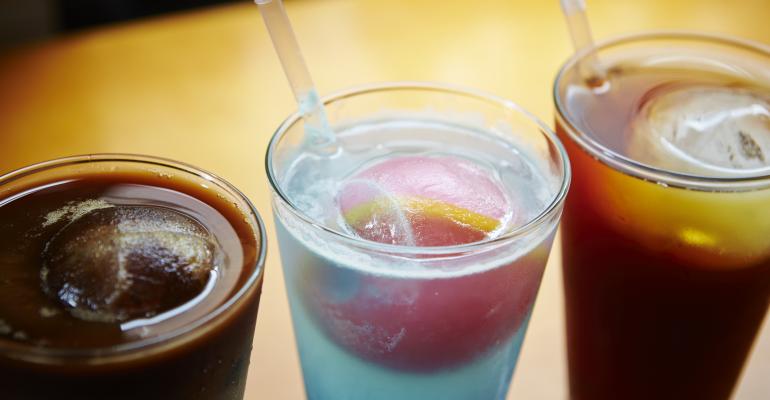Sponsored by Gevalia
Having an appealing beverage menu pays off for restaurant operators. In addition to being major profit producers, on-trend beverages enhance the customer experience and create excitement that fuels repeat patronage. The following are some tips from leading operators who have assembled a beverage mix which resonates with customers.
Emerging choices. A list of the 25 top-growing nonalcoholic beverage terms on U.S. menus by the Chicago-based market research firm Datassential shows soda substitutes and healthful ingredients increasing, albeit from a small penetration base.
One of the top terms is cold brew, which had a one-year growth of 48 percent. Other rising terms and their one-year growth rates include:
• Cow's milk substitutes like coconut milk (27 percent) and almond milk (24 percent)
• Corn syrup alternatives like cane sugar (32 percent) and agave (20 percent)
• Green vegetables such as kale (26 percent), cucumber (19 percent) and spinach (14 percent), used in juices and smoothies
• Teas like matcha (17 percent) and milk tea (14 percent) are emerging as well.
“It’s safe to say that people are interested in healthy beverages, and carbonated soft drinks are not on the list,” says Claire Conaghan, Datassential senior account manager.
Explore and innovate. At Quaker Steak & Lube, a Westlake, Ohio-based casual-dining restaurant chain in the TA Restaurant Group, adding new specialty shakes and hand-crafted sodas has recharged the nonalcoholic side of the beverage menu.
The Celuberate Cake Shake is a blend of party cake with vanilla ice cream, topped with whipped cream and sprinkles. “We moved so many that we put it on our food menu and it became somewhat of a staple,” says Shannon Salupo, corporate beverage manager. Other variations on the theme are the Red Velvet Cake Shake, Mixed Berry Shake and the new Salted Caramel Pretzel Shake.
“You can do so much with a shake at such a low cost, by changing things up,” says Salupo, “and what goes better with a burger than a shake!”
Quaker Steak & Lube’s hand-crafted sodas come in Stone Fruit (apricot, cherry and peach), and Orange Cream and Vanilla Cream flavors, each mixed with lemon-lime soda and topped with whipped cream. “The entire packaging is what makes them appealing to customers,” says Salupo. “We present them in a 20-ounce branded glass that says Flavor Injected Cool Fuel, and we market them with vibrant pictures. Consumers like to see pictures and read descriptions before they order.”
Fit the beverages to the concept. “Everything we offer is meant to go well with fried chicken and honey butter,” says Joshua Kulp, co-executive chef/managing partner of Honey Butter Fried Chicken, a fast-casual eatery in Chicago, with well-curated food and beverage menus.
Key beverage offerings are house lemonade, made with freshly squeezed lemon juice and simple syrup; sweet and unsweetened iced tea brewed in-house with premium black citron tea; and 100 percent cane sugar-sweetened fountain sodas in such varieties as root beer, orange, ginger ale, cola and grape.
Add to that a few simple cocktails made with high-quality ingredients, like The Hill Pop — house lemonade and premium bourbon — and spiked sweet tea. “They’re drinks you would be comfortable having on your front porch rather than in a cool club,” says Kulp.
Lemonade and cocktails are available upgraded with seasonal syrups made with fresh produce from the local farmers’ market. “In May it might be rhubarb syrup; in June it might be strawberry syrup; in winter we might do a basil syrup,” says Kulp. The limited-time syrups add periodic excitement to the beverage menu without the operational challenges of introducing brand-new items.
Brace for the cold wave. At Spill the Beans Coffee + Bagel in San Diego, conventional hot espresso-based drinks like macchiato, cortado, cappuccino and latte rule morning sales. However, as the day progresses, patrons gravitate to cold brew coffee — steeped in-house for 24 hours — and nitro cold brew on tap. House cold brew stars in Mr. Ed, a latte flavored with almond-rosewater syrup, and One Trick Pony, a cinnamon-laced latte. “We’re getting creative and moving away from ordinary coffee drinks,” says head barista Analiese Lasky.
The equine monikers are a nod to a local roaster, Dark Horse Coffee. Whimsical names help to drive customer interest in inventive specialties. “It makes people curious and eager to ask questions,” says Lasky.
At a time of intense competition for restaurant traffic, a well-considered beverage menu is a valuable marketing tool for operators. Promoting beverages that are acknowledged favorites — plus up-and-comers that show potential to become future staples — is an advisable path forward.




